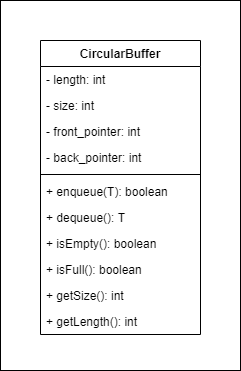In this post, I explain a particular type of queues called the circular buffer. At the end I show an example implementation using Python.
Short description
A queue is a data structure that implements the FIFO (First-In-First-Out) principle. That means, the first element added (enqueue) to the queue is the first element that gets removed (dequeue). In other areas of life, this is often referred to as a first-come, first-served principle.
A circular (or ring) buffer is a specialized typed of a queue. It is assigned a length at initialization. This length if fixed and not changed during runtime. If the queue is full, it will start to overwrite its values in a circular movement.
 Simplified schematic of a circular buffer
Simplified schematic of a circular buffer
The image shows the schematic of a circular buffer.
If a new element is enqueued, it will be inserted right to “40”, and the back_pointer will move one position right.
If a value is inserted at the most right field the “back pointer” jumps to the left end of the queue.
So the back_pointer is left to the front_pointer.
If it is one less to the “front pointer” the buffer is full.
To add a new element, one must first be removed.
Advantages
A circular buffer brings some advantages. The memory is allocated at the initialization and constant during runtime. Growing queues could be a problem if they grow faster than they shrink as they continuously allocate more memory. This problem does not exist for a circular buffer. They also do not need dynamic memory and don’t require to copy data around. This eliminates the problem of memory leaks. Another advantage is the simple and fast implementation.
Disadvantages
The fixed length could be a problem in some cases. The required length must be known beforehand and could not be changed if required.
Definitions and naming
Length: The length of the buffer is the number of elements that it could store.
Size: The size of the buffer is the number of elements that are currently stored in the buffer.
Empty: The buffer is empty if there is no element in it. This is indicated if the start_pointer and end pointer point to the same element.
Full: The buffer is full if each element is filled with a value. This indicated if the end_pointer is one less than the start_pointer.
UML Modelling
Use case diagram

The use case diagram shows the actions that the Circular buffer must provide. In the code, each action is implemented as a public function of the class.
Class diagram

The class diagram shows the required classes and their functions. Since the full buffer is implemented in a single class the diagram only contains one class. The public functions mirror the actions defined in the use case diagram.
To make the buffer definition as abstract as possible, the generic type “T” is used. This variable could be replaced by the required type (for example int, string, …). The “enqueue” function returns a Boolean value. If the value could be inserted, the function returns true. Otherwise, it will return false.
Implementation
The following code demonstrates an implementation of a Circular buffer in Python.
1
2
3
4
5
6
7
8
9
10
11
12
13
14
15
16
17
18
19
20
21
22
23
24
25
26
27
28
29
30
31
32
33
34
35
36
37
38
39
40
41
42
43
44
45
46
47
48
49
50
51
52
53
54
55
56
57
58
59
from typing import TypeVar, Optional, List
T = TypeVar("T")
class CircularBuffer(Generic[T]):
data: List[T] = []
length: int
size: int = 0
front_pointer: int = 0
back_pointer: int = 0
def __init__(self, length: int = 5):
self.length = length
self.data = [None] * length
def enqueue(self, val: T) -> bool:
if self.is_full():
return False
self.data[self.back_pointer] = val
self.back_pointer = (self.back_pointer + 1) % self.length
self.size += 1
return True
def dequeue(self) -> Optional[T]:
if self.is_empty():
return None
val: T = self.data[self.front_pointer]
self.front_pointer = (self.front_pointer + 1) % self.length
self.size -= 1
return val
def is_empty(self) -> bool:
if self.size == 0:
return True
return False
def is_full(self) -> bool:
if self.size == self.length:
return True
return False
def get_size(self) -> int:
return self.size
def get_length(self) -> int:
return self.length
In order to make the code not too long, the comments have been removed. For the full code see the Github repo.
The class uses a TypeVar so the concrete type must be provided at the initialization.
For example to use the class with int types the a new buffer is created with the following code.
1
2
3
4
5
6
7
8
9
cb = CircularBuffer[int](10)
cb.enqueue(5)
cb.enqueue(6)
cb.enqueue(7)
val = cb.dequeue()
print(val) # 5
To use another type replace int with the target type.
Conclusion
Circular buffers are handy structures. They provide a lot of advantages and can be easily implemented. Since they can be used in many different cases, every programmer should know them and should be able to implement them.


